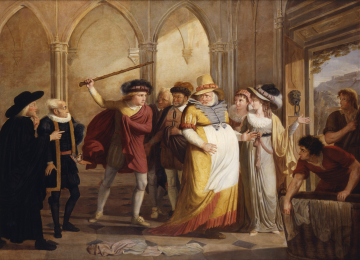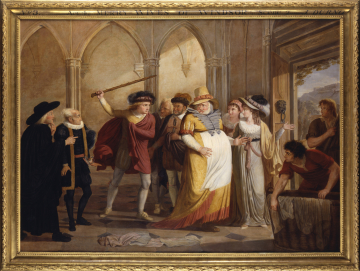Explore Collections


You are here:
CollectionsOnline
/
A scene from the Merry Wives of Windsor
Browse
SM P211. ©Sir John Soane's Museum, London. Photo: Art UK
James Durno (c.1755 - 1795)
A scene from the Merry Wives of Windsor
1788
Oil on canvas
Height: 158.5cm
Width: 218.2cm
Width: 218.2cm
Inscription: None
Museum number: P211
On display: Staircase - ground to first floor
All spaces are in No. 13 Lincoln's Inn Fields unless identified as in No. 12, Soane's first house.
For tours https://www.soane.org/your-visit
Curatorial note
The painting represents Falstaff in diguise led out by Mrs. Page from Shakespeare's The Merry Wives of Windsor, Act IV, Scene 2.
The setting is a Gothic hall, with Falstaff, dressed as a woman with a tall hat and white apron, being led towards the door by Mistress Page. She and Mistress Ford have persuaded Sir John Falstaff, visiting them without the knowledge of their jealous husbands, rather than hiding on the unexpected arrival of Master Ford, to dress in women's clothes and pretend to be Mistress Page's obese aunt, the "fat woman of Brentford." Here we see Ford (to the left), raising his stick threateningly and driving the supposed aunt from the house. The onlookers include a man looking up from a large wash tub on the right.
Durno enrolled at the Royal Academy in February 1769 and may have met Soane during his time there - Soane enrolled in October 1771. In 1774 Durno left for Italy where he remained until his death. He was living with the English sculptor Thomas Banks and his wife at the top of the Spanish steps when Soane arrived in Rome in March 1778. Soane's early patron in Italy, Frederick Hervey, Bishop of Derry and 4th Early of Bristol, also knew him in Rome and commissioned several large-scale history paintings from him, at least some of which were in preparation while Soane was there and it seems likely that if Soane did not already know Durno he met him in Rome either through Banks or with the Earl-Bishop.
Soane left Rome in 1780 and shortly after his return home severed his relations with the Earl-Bishop but it is interesting that later in that decade Durno produced a small-scale version of this picture with a pendant work depicting Falstaff and the recruits, for the Earl-Bishop (1786). He subsequently repeated this pair of successful compositions several times, including the two large versions for John Boydell's Shakespeare Gallery of which this work is one.
The Shakespeare Gallery was a collection of paintings "illustrating the poetry of our Great Bard" and intended as "a proud Display of National Talent". Lord Farnborough recommended Durno to Boydell, who also commissioned other artists such as Reynolds and Romney.
This painting was well received in London when it went on show, the reviewer in the Public Advertiser describing it as having parts finished with all "the delicacy of a miniature". It has been suggested that the physiognomy of Falstaff is based on that of the actor John Henderson, famed for his interpretation of the role. This seems to be based on the friendship in Rome between Durno and Henry Fuseli, who based his depiction of Falstaff in 'Falstaff and Doll Tear-sheet' (Kunsthaus, Zurich, and engraved version) on Henderson. Experts on Shakespearean performance, however, feel that the painting is entirely fictional and romantic and does not show actors of the time citing the fact that the intention of the Boydell paintings was 'to make 'real' the fiction of the Shakespeare plays with the effect to of removing them far from staging and the theatre' (Stern). The landscape seen through the doorway seems Italianate, rather then English - certainly not the Windsor of Shakespeare's play - reflecting the Roman campagna so familiar to Durno at the time.
Today, the painting remains where Soane originally hung it in 1805. It is symbolically positioned between a recess at the foot of the stairs containing a Flaxman sculpture illustrating a scene from Milton's epic poem 'Paradise Lost', and another recess further up the staircase, the 'Shakespeare Recess' containing an arrangement of paintings and sculpture paying homage to the great playwright. The painting dominates the staircase all the more since it, and its gilded frame, were cleaned and restored (1998), revealing the full richness of the work.
The beautifully carved frame appears to have been cut down to take this painting - probably by the artist himself, and it is almost certainly the frame in which the painting was shown by Boydell. On the top left hand corner of the frame, 'No.3' has been inscribed, implying that there may have been a third Shakespearean painting by Durno. According to the Shakespeare Gallery sale catalogue (1805), the Falstaff pair were the only two works by Durno on show, there is some evidence that a third scene was in preparation.
The setting is a Gothic hall, with Falstaff, dressed as a woman with a tall hat and white apron, being led towards the door by Mistress Page. She and Mistress Ford have persuaded Sir John Falstaff, visiting them without the knowledge of their jealous husbands, rather than hiding on the unexpected arrival of Master Ford, to dress in women's clothes and pretend to be Mistress Page's obese aunt, the "fat woman of Brentford." Here we see Ford (to the left), raising his stick threateningly and driving the supposed aunt from the house. The onlookers include a man looking up from a large wash tub on the right.
Durno enrolled at the Royal Academy in February 1769 and may have met Soane during his time there - Soane enrolled in October 1771. In 1774 Durno left for Italy where he remained until his death. He was living with the English sculptor Thomas Banks and his wife at the top of the Spanish steps when Soane arrived in Rome in March 1778. Soane's early patron in Italy, Frederick Hervey, Bishop of Derry and 4th Early of Bristol, also knew him in Rome and commissioned several large-scale history paintings from him, at least some of which were in preparation while Soane was there and it seems likely that if Soane did not already know Durno he met him in Rome either through Banks or with the Earl-Bishop.
Soane left Rome in 1780 and shortly after his return home severed his relations with the Earl-Bishop but it is interesting that later in that decade Durno produced a small-scale version of this picture with a pendant work depicting Falstaff and the recruits, for the Earl-Bishop (1786). He subsequently repeated this pair of successful compositions several times, including the two large versions for John Boydell's Shakespeare Gallery of which this work is one.
The Shakespeare Gallery was a collection of paintings "illustrating the poetry of our Great Bard" and intended as "a proud Display of National Talent". Lord Farnborough recommended Durno to Boydell, who also commissioned other artists such as Reynolds and Romney.
This painting was well received in London when it went on show, the reviewer in the Public Advertiser describing it as having parts finished with all "the delicacy of a miniature". It has been suggested that the physiognomy of Falstaff is based on that of the actor John Henderson, famed for his interpretation of the role. This seems to be based on the friendship in Rome between Durno and Henry Fuseli, who based his depiction of Falstaff in 'Falstaff and Doll Tear-sheet' (Kunsthaus, Zurich, and engraved version) on Henderson. Experts on Shakespearean performance, however, feel that the painting is entirely fictional and romantic and does not show actors of the time citing the fact that the intention of the Boydell paintings was 'to make 'real' the fiction of the Shakespeare plays with the effect to of removing them far from staging and the theatre' (Stern). The landscape seen through the doorway seems Italianate, rather then English - certainly not the Windsor of Shakespeare's play - reflecting the Roman campagna so familiar to Durno at the time.
Today, the painting remains where Soane originally hung it in 1805. It is symbolically positioned between a recess at the foot of the stairs containing a Flaxman sculpture illustrating a scene from Milton's epic poem 'Paradise Lost', and another recess further up the staircase, the 'Shakespeare Recess' containing an arrangement of paintings and sculpture paying homage to the great playwright. The painting dominates the staircase all the more since it, and its gilded frame, were cleaned and restored (1998), revealing the full richness of the work.
The beautifully carved frame appears to have been cut down to take this painting - probably by the artist himself, and it is almost certainly the frame in which the painting was shown by Boydell. On the top left hand corner of the frame, 'No.3' has been inscribed, implying that there may have been a third Shakespearean painting by Durno. According to the Shakespeare Gallery sale catalogue (1805), the Falstaff pair were the only two works by Durno on show, there is some evidence that a third scene was in preparation.
This work was painted in Rome. It is one of a pair commissioned by Alderman John Boydell for his celebrated Shakespeare Gallery and was purchased by John Soane at the sale of the contents of the Shakespeare Gallery at Christie's in 1805 (Lot.31 on Saturday 18 May).
Literature
Soane, Description, 1830, pp.21 and 40
Soane, Description, 1835, p. 56
Friedman, W., Boydell's Shakespeare Gallery, New York, 1976
Cannon-Brookes, P. (ed.), The Painted Word: British History Painting 1750-1830, exhibition catalogue, Heim, Jermyn Street, 1991, pp. 108-109
Thornton and Dorey, Miscellany, 1992, p.124
New Description, Sir John Soane's Museum, 2007, pp.73 and 98
Ashton. G., Shakespeare, His Life and works in paintings, prints and ephemera, London, 1990
Lowell Libson & Jonny Yarker Limited, Recent Acquisitions 2019/20, pp.38-48 catalogue entry for Durno's Priam returning to Troy with the body of Hector, illustration p.42
Catalogue entry for pair of Durno works [not dated] on the website of Galleria Carlo Virgilia & C., Via delle Lupa, Rome; unpublished correspondence with Professor Tiffany Stern 2021 (Soane object file)
Soane, Description, 1835, p. 56
Friedman, W., Boydell's Shakespeare Gallery, New York, 1976
Cannon-Brookes, P. (ed.), The Painted Word: British History Painting 1750-1830, exhibition catalogue, Heim, Jermyn Street, 1991, pp. 108-109
Thornton and Dorey, Miscellany, 1992, p.124
New Description, Sir John Soane's Museum, 2007, pp.73 and 98
Ashton. G., Shakespeare, His Life and works in paintings, prints and ephemera, London, 1990
Lowell Libson & Jonny Yarker Limited, Recent Acquisitions 2019/20, pp.38-48 catalogue entry for Durno's Priam returning to Troy with the body of Hector, illustration p.42
Catalogue entry for pair of Durno works [not dated] on the website of Galleria Carlo Virgilia & C., Via delle Lupa, Rome; unpublished correspondence with Professor Tiffany Stern 2021 (Soane object file)
Soane collections online is being continually updated. If you wish to find out more or if you have any further information about this object please contact us: worksofart@soane.org.uk





